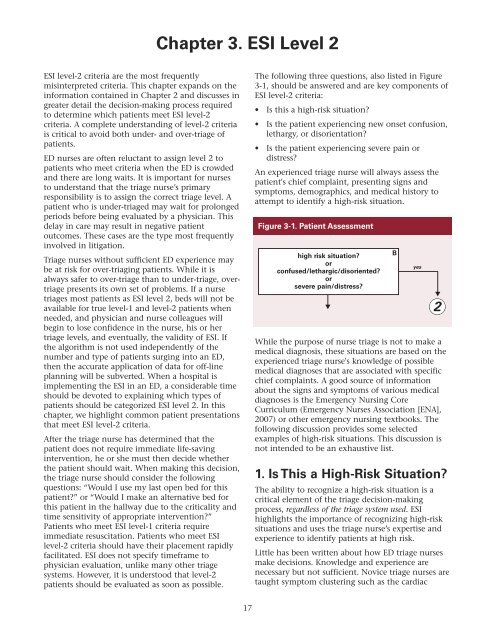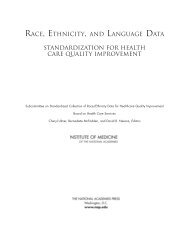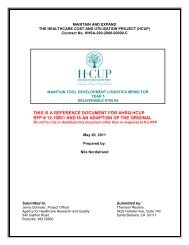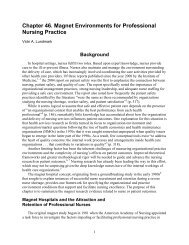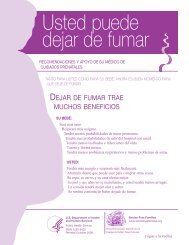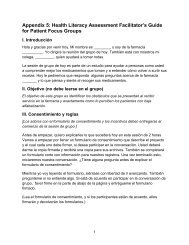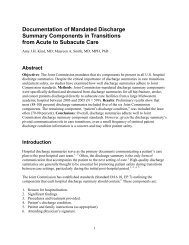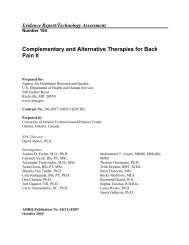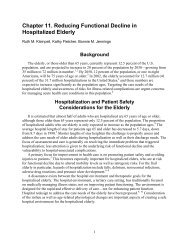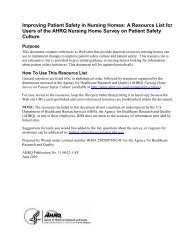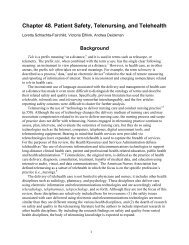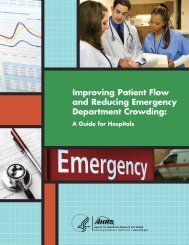Emergency Severity Index (ESI): A Triage Tool for Emergency ...
Emergency Severity Index (ESI): A Triage Tool for Emergency ...
Emergency Severity Index (ESI): A Triage Tool for Emergency ...
Create successful ePaper yourself
Turn your PDF publications into a flip-book with our unique Google optimized e-Paper software.
<strong>ESI</strong> level-2 criteria are the most frequently<br />
misinterpreted criteria. This chapter expands on the<br />
in<strong>for</strong>mation contained in Chapter 2 and discusses in<br />
greater detail the decision-making process required<br />
to determine which patients meet <strong>ESI</strong> level-2<br />
criteria. A complete understanding of level-2 criteria<br />
is critical to avoid both under- and over-triage of<br />
patients.<br />
ED nurses are often reluctant to assign level 2 to<br />
patients who meet criteria when the ED is crowded<br />
and there are long waits. It is important <strong>for</strong> nurses<br />
to understand that the triage nurse’s primary<br />
responsibility is to assign the correct triage level. A<br />
patient who is under-triaged may wait <strong>for</strong> prolonged<br />
periods be<strong>for</strong>e being evaluated by a physician. This<br />
delay in care may result in negative patient<br />
outcomes. These cases are the type most frequently<br />
involved in litigation.<br />
<strong>Triage</strong> nurses without sufficient ED experience may<br />
be at risk <strong>for</strong> over-triaging patients. While it is<br />
always safer to over-triage than to under-triage, overtriage<br />
presents its own set of problems. If a nurse<br />
triages most patients as <strong>ESI</strong> level 2, beds will not be<br />
available <strong>for</strong> true level-1 and level-2 patients when<br />
needed, and physician and nurse colleagues will<br />
begin to lose confidence in the nurse, his or her<br />
triage levels, and eventually, the validity of <strong>ESI</strong>. If<br />
the algorithm is not used independently of the<br />
number and type of patients surging into an ED,<br />
then the accurate application of data <strong>for</strong> off-line<br />
planning will be subverted. When a hospital is<br />
implementing the <strong>ESI</strong> in an ED, a considerable time<br />
should be devoted to explaining which types of<br />
patients should be categorized <strong>ESI</strong> level 2. In this<br />
chapter, we highlight common patient presentations<br />
that meet <strong>ESI</strong> level-2 criteria.<br />
After the triage nurse has determined that the<br />
patient does not require immediate life-saving<br />
intervention, he or she must then decide whether<br />
the patient should wait. When making this decision,<br />
the triage nurse should consider the following<br />
questions: “Would I use my last open bed <strong>for</strong> this<br />
patient?” or “Would I make an alternative bed <strong>for</strong><br />
this patient in the hallway due to the criticality and<br />
time sensitivity of appropriate intervention?”<br />
Patients who meet <strong>ESI</strong> level-1 criteria require<br />
immediate resuscitation. Patients who meet <strong>ESI</strong><br />
level-2 criteria should have their placement rapidly<br />
facilitated. <strong>ESI</strong> does not specify timeframe to<br />
physician evaluation, unlike many other triage<br />
systems. However, it is understood that level-2<br />
patients should be evaluated as soon as possible.<br />
Chapter 3. <strong>ESI</strong> Level 2<br />
17<br />
The following three questions, also listed in Figure<br />
3-1, should be answered and are key components of<br />
<strong>ESI</strong> level-2 criteria:<br />
• Is this a high-risk situation?<br />
• Is the patient experiencing new onset confusion,<br />
lethargy, or disorientation?<br />
• Is the patient experiencing severe pain or<br />
distress?<br />
An experienced triage nurse will always assess the<br />
patient's chief complaint, presenting signs and<br />
symptoms, demographics, and medical history to<br />
attempt to identify a high-risk situation.<br />
Figure 3-1. Patient Assessment<br />
While the purpose of nurse triage is not to make a<br />
medical diagnosis, these situations are based on the<br />
experienced triage nurse's knowledge of possible<br />
medical diagnoses that are associated with specific<br />
chief complaints. A good source of in<strong>for</strong>mation<br />
about the signs and symptoms of various medical<br />
diagnoses is the <strong>Emergency</strong> Nursing Core<br />
Curriculum (<strong>Emergency</strong> Nurses Association [ENA],<br />
2007) or other emergency nursing textbooks. The<br />
following discussion provides some selected<br />
examples of high-risk situations. This discussion is<br />
not intended to be an exhaustive list.<br />
1. Is This a High-Risk Situation?<br />
The ability to recognize a high-risk situation is a<br />
critical element of the triage decision-making<br />
process, regardless of the triage system used. <strong>ESI</strong><br />
highlights the importance of recognizing high-risk<br />
situations and uses the triage nurse’s expertise and<br />
experience to identify patients at high risk.<br />
Little has been written about how ED triage nurses<br />
make decisions. Knowledge and experience are<br />
necessary but not sufficient. Novice triage nurses are<br />
taught symptom clustering such as the cardiac


